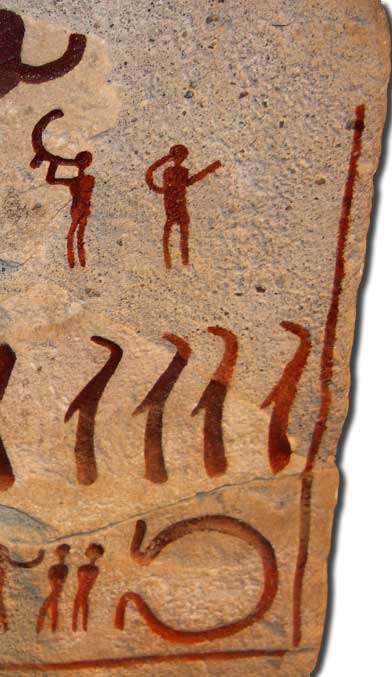

Condensing scientific research and artistic creativity; ancient knowledge and modern technologies; as well as music and archaeology the activities of EMAP span a period of five years, from 2013 to 2018, and see the collaboration of seven countries and ten European institutions, while its “Etruscan” control room is based in Tarquinia.
From the Upper Paleolithic period (ca 40,000 B.C.) to the Iron Age, from the great classical civilizations to the Middle Ages and beyond, we witness a “decantation” that often leads to the traditional music that is still present in various areas of the continent and the Mediterranean basin. It is a journey between archaeology and art (not exclusively music art), science and creativity.
 One of the key events is a large exhibition with multimedia features that allows visitors to admire and fully experience the prodigious reality of the musical instruments and their amazing journey through time and space. Visitors have the opportunity to touch the instruments and actually hear the sounds they make, and see the “sound-evidence” of the crucial role played by music in ancient societies. The project is also producing workshops, conferences, concerts, books, CDs, DVDs, and educational materials. A documentary maps out a detailed timeline starting from the archaeological find, the accurate reconstruction of the instruments, and finally the performance that brings the ancient instruments back to life.
One of the key events is a large exhibition with multimedia features that allows visitors to admire and fully experience the prodigious reality of the musical instruments and their amazing journey through time and space. Visitors have the opportunity to touch the instruments and actually hear the sounds they make, and see the “sound-evidence” of the crucial role played by music in ancient societies. The project is also producing workshops, conferences, concerts, books, CDs, DVDs, and educational materials. A documentary maps out a detailed timeline starting from the archaeological find, the accurate reconstruction of the instruments, and finally the performance that brings the ancient instruments back to life.
In order to do this, EMAP has recruited a team of archaeologists, musicologists, researchers, makers of musical instruments, composers, musicians, film-makers, sound designers and multimedia artists, and put them together with the scientific and organizational support of universities, museums, public bodies, music festivals, research centers, music archives and academies. The EU is funding 50% of the project budget of approximately 4 million Euros. The remaining 50% is funded by the ten institutions taking part in the project and by the proceeds from the various initiatives connected to the project.
EMAP travelled in time from the Upper Paleolithic period (ca 40,000 B.C.), the era some ancient findings date back to, to the great classical civilizations. Experts examined the survival and resilience of ancient music making, as witnessed in the traditional music that is still alive in Europe and in the Mediterranean basin. The main attractions of the project are some of the most fascinating musical devices ever created by man during different historical periods and the many interconnections they produced. We get acquainted with bone flutes, bullroarers, shells and other musical traces scattered all over Europe by Homo sapiens, and perhaps even by his Neanderthal predecessor.
 We rediscovered the lyre and other chordophones, which were used in the central and northern areas of the European Continent, despite originating in the Mediterranean basin; and conversely, the metal horns that travelled from the Baltic region and the British Isles during the Bronze Age towards the South of France and Etruria. We discovered the majestic lituus found during excavations in Tarquinia, an instrument that the Etruscans shared with the Romans and the Celts; the carnyx, another spectacular bronze trumpet of Celtic origin with a zoomorphic bell-shape; and then double pipes (like the Greek aulos or the Roman tibiae), flutes, Pan-pipes, lithophones, rattles, sistra, gongs, cymbals, scrapers and many other percussion instruments.
We rediscovered the lyre and other chordophones, which were used in the central and northern areas of the European Continent, despite originating in the Mediterranean basin; and conversely, the metal horns that travelled from the Baltic region and the British Isles during the Bronze Age towards the South of France and Etruria. We discovered the majestic lituus found during excavations in Tarquinia, an instrument that the Etruscans shared with the Romans and the Celts; the carnyx, another spectacular bronze trumpet of Celtic origin with a zoomorphic bell-shape; and then double pipes (like the Greek aulos or the Roman tibiae), flutes, Pan-pipes, lithophones, rattles, sistra, gongs, cymbals, scrapers and many other percussion instruments.EMAP adopted innovative methods of investigation, reconstruction and “staging”, as well as technical and aesthetic solutions that combine scientific accuracy with artistic passion and a desire to share this knowledge. Augmented Reality, for instance, will be used to enable people to explore and virtually touch 3D replicas of the instruments, while in one of the islands of sound of the exhibition, the Soundgate, experts recreated the acoustics of the original environments in which the ancient instruments were played (a prehistoric cave, a megalithic monument like Stonehenge, or an ancient theater).


